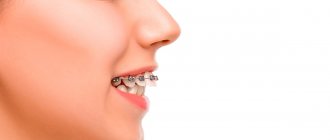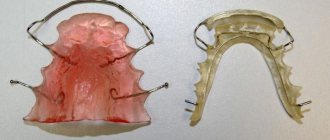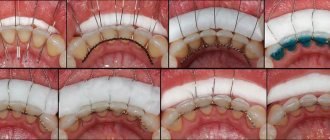Why do teeth hurt with braces? The fact is that during orthodontic treatment, a targeted physical effect is applied to the dental system, changing its usual state. The traction of the orthodontic arch causes irritation of the nerve endings, and the body’s response becomes unpleasant and sometimes very painful sensations. The degree of their severity depends on a number of factors - age, gender, clinical situation and individual reaction to stress. Therefore, doctors cannot offer a universal remedy to relieve patients of discomfort, but, of course, it is possible to alleviate the unpleasant sensations that arise at different stages of correction.
Does it hurt to get braces?
Depending on the chosen method of fixing the locks on the teeth, the procedure lasts up to 2–3 hours. It is not accompanied by painful sensations; the patient may experience some discomfort only from prolonged sitting in a chair.
But do not forget that before installing braces, the oral cavity is sanitized. It includes treatment of tooth decay and gum disease, as well as professional teeth cleaning to remove soft deposits and tartar. In some cases, in order to securely fix the braces, it is necessary to lightly process the tooth enamel. When performing the corresponding manipulations, painful sensations may occur, from which the patient is relieved by safe local anesthesia.
What are braces?
Braces are one of the most advanced and progressive methods of orthodontic treatment.
Its advantages include the ability to correct complex dental anomalies and control tooth movement. Thanks to this, braces remain the leading direction for correcting malocclusion and other disorders [1]. The bracket system is a complex structure. Traditionally it includes:
- An archwire is a thin and flexible metal cord that passes through the clasps on all the teeth covered by the braces system. The arch is made of a special metal that has memory and can take a given position, gradually “pulling” the teeth along with it and thereby aligning their position in the oral cavity. The thicker the arc, the stronger its effect.
- Braces are special clasps made of metal, polymer or ceramic. They are glued to the surface of each tooth that is to be affected by the device. An arch passes through all the braces, thus transferring force to the teeth.
- A ligature is an element of a lock that fixes the arch, preventing it from moving.
Currently, both ligature and non-ligature or self-ligating systems are used. In the latter, the fixing elements are built into the locks.
The disadvantages of braces include increased hygiene requirements, the need for frequent adjustments by a specialist, some discomfort during installation and wearing, as well as aesthetic defects.
Why do my teeth hurt after getting braces?
Discomfort is caused by two reasons.
- The orthodontic arch puts a lot of pressure on the teeth. When changing position, they, in turn, affect the ligaments, causing them to compress on one side and stretch on the other, and on bone tissue. When developing a treatment program, the orthodontist tries to calculate the traction force of the arch so that the correction is effective and the pain is tolerable.
- During the adjustment period, protruding elements of the braces system can injure the mucous membranes of the cheeks, tongue and lips. The patient will be given orthodontic wax and given instructions on its use. Applied to problem areas, wax will protect the mucous membranes from chafing and irritation, significantly reducing discomfort.
Pain when wearing braces that is not normal
Above we described discomfort with braces, which is normal. But some painful sensations indicate inflammatory or pathological processes.
The fact is that orthodontic treatment is a serious test for the body. The entire dental system is being rebuilt and requires special monitoring and care.
What sensations may indicate the presence of dental diseases:
- Aching and sharp pain in individual teeth
can be caused by caries or inflammation of the canals. - Pain in the area of contact between the gums and teeth
as a result of recession - loss of gums. Recession often accompanies orthodontic treatment, as the roots of the teeth move and put pressure on the periodontal tissue, which can cause gradual gum resorption. - Pain in the temporomandibular joint.
Some patients are predisposed to TMJ dysfunction - the joint can move into a new position during orthodontic treatment and cause discomfort and discomfort. You must report them to the orthodontist - the doctor will take the necessary measures. - Enamel sensitivity
. Braces make hygiene difficult and can weaken tooth enamel. If the enamel is excessively sensitive, you should definitely visit a therapist or hygienist. A specialist will clean and remineralize your teeth.
To prevent the development of inflammation, undergo professional hygiene and a preventive examination with a therapist at least once every six months. Report any strange or sharp sensations in your teeth, gums and joints to your orthodontist.
Why do my teeth hurt from braces after activating treatment?
Painful sensations return for several days when the system is activated. After a certain time, the teeth are aligned, the bite is corrected, the ligatures are stretched, and the force of the arc decreases. To restore the effectiveness of ligature braces, the doctor periodically corrects them:
- after 3–4 weeks, renews ligatures;
- after 2–3 months, replaces the arch;
- At each appointment, checks the secure fastening of the locks.
Self-ligating systems need to be activated less frequently. The severity of pain depends on the individual pain threshold and the condition of the dental system. Typically, teeth respond to the next increase in traction within 2–3 days.
Alternative techniques
In cases where the problem of tooth sensitivity is pronounced, alternative methods for correcting malocclusion can be used. The use of removable aligners allows not only to avoid these symptoms, but also to eliminate such a serious drawback of treatment with braces as a violation of aesthetics. Aligners are effective, comfortable, and invisible to others. In addition, their use allows you to perform hygiene procedures in full.
However, no matter what method of bite correction the patient uses, to obtain the desired effect, the professional qualities of the orthodontist are the priority. Specialist Irina Aleksandrovna Butorina has the highest qualifications and extensive practical experience, which allows her to find the most optimal solution in each case and obtain the desired result even with increased tooth sensitivity.
Why do my teeth hurt after braces are removed?
The procedure for removing the system is painless. After removing the archwire, the attending physician, using a special tool, removes the clasps and polishes the enamel to remove any remnants of the fixing compound.
In some patients, the enamel may become especially sensitive after wearing braces. It will react to hot and cold drinks and foods, salty and sour foods, etc. To prevent the appearance of hypersensitivity, it is restored with the help of special gels, varnishes and toothpastes.
After the braces are removed, the teeth that are lined up in an even row will try to return to their previous position. This may also cause pain. To maintain the results of treatment, patients have to wear a so-called retainer. A non-removable plate attached to the inside of the teeth or a transparent removable mouthguard will hold the teeth in the desired position, secure the result of the correction and relieve discomfort.
Preventive actions
To exclude negative phenomena, before installing braces, it is necessary to determine with the orthodontist the nature and mechanism of hygienic procedures, and clarify the necessary means. This is especially acute in cases where the patient initially notes increased sensitivity of the teeth. If such symptoms occur during treatment, it is also necessary to discuss the problem with a specialist. Carrying out regular hygiene procedures in the dental office helps prevent such undesirable phenomena.
How to relieve toothache from braces?
- Take the pain reliever at the dosage prescribed by your doctor and at the recommended frequency.
- Use local anesthetics - gels and mouthwashes that dull the pain for a couple of hours.
- Baths with warm salt water soothe pain and heal abrasions of the soft tissues of the oral cavity. The solution should be kept in the mouth for about a minute, and the procedure should be repeated several times a day.
- Relieve inflammation by rinsing or bathing with 3% hydrogen peroxide, which has an antiseptic effect. The 1:1 solution is also kept in the mouth for about a minute. You can also buy a ready-made peroxide-based rinse at the pharmacy.
- Use specialized wax as needed. After tearing off a piece, roll it into a pea, dry the problematic metal element with a napkin and press the pea onto it.
What will help you cope with pain?
If your teeth hurt from braces for more than a week, it is recommended to check with your dentist how the system is installed. In some cases, locks and bridges may have been secured incorrectly, causing severe discomfort. To eliminate pain, it is recommended to take the following measures:
- change diet;
- use painkillers;
- apply dental wax;
- massage the oral cavity;
- Rinse your mouth daily with saline solution.
If oral hygiene and system care rules are observed, the pain quickly passes or is completely absent.
Diet restrictions
Food can harm your health when correcting your bite or break your braces. To prevent the development of pain in sensitive teeth, it is recommended to adhere to the following principles:
- Consume chilled food or drinks. A slight decrease in temperature will help dull the pain and relieve discomfort. If teeth are hypersensitive, apply an ice pack over the lesion. This method not only eliminates pain, but also helps relieve irritation of the mucous membranes and swelling.
- Eliminate foods rich in organic acids from your diet. Berries and citrus fruits can increase discomfort. Acids slow down the healing of wounds caused by friction between systems.
- Avoid eating solid foods, vegetables and fruits rich in coarse fiber, and sticky foods. A high content of dietary fiber, high density of the product consumed, and tough fibrous meat can damage braces and teeth. Taffy, honey, and chewy caramel have a similar effect.
- Eat soft foods: yoghurts, purees, kefir, porridge.
Within an hour after installing the device, you must refuse food. After 60 minutes, liquid, softened foods are allowed. The basis of the diet is:
- cereal porridge;
- vegetable and fruit purees;
- dairy products;
- soups;
- yogurt;
- infant formula for artificial feeding.
After eating food, you must brush your teeth thoroughly to prevent the formation of hard plaque and rotting of stuck food.
Special wax
The orthodontic agent is applied to the metal structure. Wax reduces the intensity of pain. It envelops the locks and the spring, reducing friction with the mucous membranes. As a result, pain and discomfort are relieved.
Taking painkillers
If there is enamel hypersensitivity, painkillers are prescribed:
- Local anesthetics: Lidocaine. Gels and ointments are applied to damaged mucous membranes of the gums and cheeks. The active substances penetrate through the tissues to the nerves, where they block the transmission of impulses. As a result, pain signals do not reach the brain, and the person does not feel discomfort.
- Plates for chewing or sucking. Indicated on the first day after installing braces.
- Oral agents. The dentist prescribes Ibuprofen, Anbesol or Paracetamol. If blood clotting is normal, taking Aspirin together with orthodontic wax is recommended.











